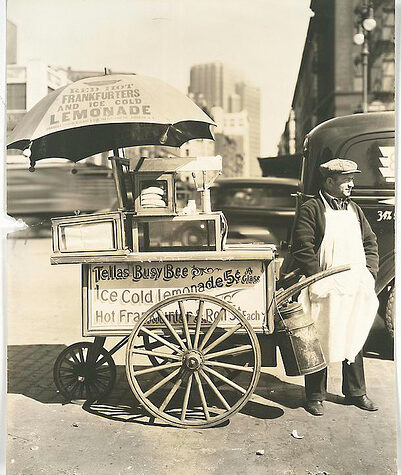In 1907 Clifford Twombly moved to Lancaster from New England to become the rector of St. James Episcopal Church. When Twombly worked at his office in the rectory, he could see a wide swath of Lancaster’s shoppers, factory workers and store clerks walk past by his window; he also probably saw prostitutes walking the streets. Perhaps citizens in need knocked on the side door of the rectory which led directly to his office. Twombly knew well that the main industries of Lancaster–textiles and tobacco–exploited workers who lived in dilapidated housing and suffered from poor health. Twombly saw that vice in Lancaster was a thriving business–an open secret encouraged by city officials. He set out to challenge the status quo. He joined with other clergy and business leaders to “put the lid on” vice.
He didn’t just oppose prostitution; he railed against the conditions that he believed caused prostitution. He sought higher wages for working women and he preached against the sexual double standard, that encouraged men to “sow their wild oats” (perhaps with prostitutes), but considered promiscuous women to be “ruined.” There should be a single standard of sexual morality, said Twombly, men should practice the same sexual restraint expected of women. He thought prostitution was “chiefly a man’s problem.” Twombly, like other reformers, thought women needed to be empowered economically to avoid prostitution. It is not surprising then that he also supported voting rights for women.
Let’s take a closer look at Twombly’s effort to improve women’s wages as a way to help Lancaster’s women stay out of commercial sex.
Most prostitutes came from working-class families of all races and immigrant groups. They were usually women who lacked a male breadwinner in their lives, which was the family ideal at the time. Fathers or husbands died, deserted the family, or lacked stable employment. If a woman was “on her own” with young children, her employment options were even more limited. In many cases, there was no other way for a woman to get by at this time.
Women who worked in cotton mills, department stores, or tobacco factories in Lancaster often supplemented their income with commercial sex after work, or they exchanged sex for movie tickets or restaurant meals. Their meager wages–perhaps from 4.50 to 7$ week, on average as compared to men’s wages, which were more likely to be around $10/week. Those who lived alone in furnished rooms or boarding houses consumed their earnings in rent, meals, and clothing. This was a time when new forms of entertainment and consumerism were rapidly emerging. There were movies to attend and dance halls to visit. There were clothes and cosmetics to buy– if you could afford them. Wage-earning women who lived with their families usually had to turn over their pay to their parents. Thus, although wage-earning women had freedom on the streets, they lacked economic independence.
Twombly was outspoken about how poor wages led to vice in this city. In 1913 he concluded that $6.50/week was the minimum that women needed to earn to survive; he emphasized that if they lived on their own, they would spend every cent of that wage. Twombly openly preached that the leaders of Lancaster could “no longer ignore the fact that a powerful creator of prostitution is our economic life.” He asked, “What about our women tobacco strippers in Lancaster; our girls in the silk mill; and our children in the cotton mills?” And then offered this bleak image:
Outside of a certain large factory on pay days when a degraded and contemptible class of young men wait outside to receive the meager pay envelopes of the girls who support these men who have ruined them.
Even these strong images were not enough to sway the state legislature, which did not pass a minimum wage for women (unlike several other states). But Twombly did not stop there. He encouraged the businessmen in his anti-vice association (the Law and Order Society) and in his church to raise women’s wages voluntarily. He had some success here. Armstrong Cork adopted Twombly’s suggested minimum wage for women of 6.50 per week. Ultimately, four industries backed Twombly’s plan.
The campaign to improve women’s wages shows that Twombly and other anti-vice activists were concerned about getting to the root of the problem of vice and that they focused on structures of poverty, not individual morality. Nevertheless, we should not celebrate Twombly’s minimum wage campaign uncritically. When he calculated the minimum wage, he never imagined that women had anyone to support but themselves. And the effort to create a minimum wage for women workers was based on the idea that white women needed protection because of their obligations as mothers. The campaign to raise women’s wages was more paternalistic than empowering.
Resource List:
Twombly criticized “starvation wages” in this article: “Minister’s Plea for Wage Earners,” Lancaster Intelligencer, 28 Jan 1914.
“The Minimum Wage for Women Workers: Statement by a Prominent Local Manufacturer,” Lancaster New Era, 26 Nov. 1913.
Peiss, Kathy. “Charity Girls and City Pleasures,” OAH Magazine of History vol. 18, no. 4 (January 2004), pp. 14-16.
Wood, Sharon. The Freedom of the Streets: Work, Citizenship, and Sexuality in a Gilded Age City. Chapel Hill, University of North Carolina Press, 2005.
Make your inbox more interesting. Subscribe to our newsletter for the latest scoop.




